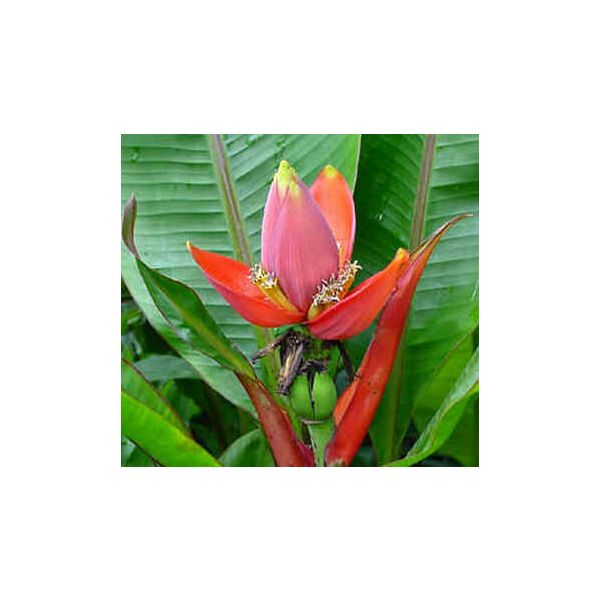Musa Laterita Seeds (Bronze Banana Seeds)
Musa Laterita Seeds (Bronze Banana Seeds)
This Indian dwarf banana tree has large, colorful flowers that appear with bright salmon-red bracts.

Delivery
All orders shipped with UPS Express.
Always free shipping for orders over US $250.
All orders are shipped with a UPS tracking number.
Returns
Items returned within 14 days of their original shipment date in same as new condition will be eligible for a full refund or store credit.
Refunds will be charged back to the original form of payment used for purchase.
Customer is responsible for shipping charges when making returns and shipping/handling fees of original purchase is non-refundable.
All sale items are final purchases.
Help
Give us a shout if you have any other questions and/or concerns.
Email: contact@domain.com
Phone: +1 (23) 456 789
Availability: In stock
SKU
Musa Laterita
Musa Laterita is called Heliconia, Bird of Paradise Banana or Bronze Banana and is from north-eastern India, Burma (Myanmar). This banana tree belongs to the Musaceae family. Bird of Paradise Banana is a superb new ornamental banana tree with elegant, slender upright leaves with darker midribs producing suckers from the base. This Indian dwarf banana tree has large, colorful flowers that appear with bright salmon-red bracts. Musa Laterita is a small section of the Rhodochlamys specie.
This dwarf tree sends up suckers that are born on long rhizomes at long distances from the parent main stem base and formes only lax open stools. The green pseudostems are slender, reaching up to 3 - 6 ft (1 - 2 m) high, and they are devoid of any perceptible wax bloom. The leaves are about 3 ft (1 m) long and 12 in (30.48 cm) wide and taper gradually to the slender petioles. The leaf blades are a bright green on top, scarcely paler under, truncate at the apex, with a reddish midrib and taper very gradually to an acute base into the leaf stalk or petiole. The petioles are about 15 ? 20 in (40 - 50 cm) long, and they closely clasp the pseudostem base and soon become rare at the region of junction. MusaLateritamay not be a hardy type, but is notable for its extreme upright habit, that is, the leaves don't spread, but point upwards.
As the stem reaches maturity, when it is about 3 ? 5 ft high (1 ? 1.5 m) high, an erect inflorescence develops from the apical portion of the stem. The inflorescence is upright and has brick-red bracts, similar in color to the tropical soil laterite that gives the specie its name, subtending yellow female flowers borne at the ends of little green bananas. The peduncle is velvety with a dense, minute puberulence. The first sterile bract is usually a foliage leaf with a broadened petiole developing the red color, and then, it is followed by one sterile true bract 8 ? 12 in (20 - 30 cm). long. Small green fruits develop which sometimes mature and produce seeds.
The flowers are bright yellow on opening and rather conspicuous. The first flowers of the basal bract to open are functionally female and they must be pollinated and fertilized before any fruits will develop, usually about 4 "hands" of 4 - 6 flowers each. The female flowers are 2.8 ? 3.1 in (7 - 8 cm) long. Self fertilization is prevented by the male flowers, darker in color than the rest, developing on the inflorescence after the female flowers are no longer receptive. The male bud, in advanced blooming, is ovate, and the bracts slightly imbricate at the tip. The bracts are slightly glaucous on the outside and rather strongly sulcate, without wax on the inside and transversely corrugated between the ridges. The male flowers are grouped 6 - 10 per bract in two rows, and the compound tepal is about 4 cm. long, 1.8 cm. wide, orange-yellow, with its tip and lobes slightly darker.
The fruit bunch is very compact because the fruits are almost appressed to the rachis. Individual fruits are about 8 - 10 cm. long, 2 cm. in diameter (fresh), on a very short pedicel and with a short but pronounced acumen, and they remain strongly angled, even at full ripeness. The fruits become yellowish when ripe but are not edible, the flesh being insipid and full of small black seeds.
Hardiness zone :
8 ? 11(-10c/15f, 4c/40f). Musa Laterita does well in a pot despite its spreading habit and will produce flowers. This tree likes rich organic compost and will require liberal fertilizing when established.
| Label | Musa laterita |
|---|---|
| Common name | Bronze Banana |
| Genus | Musa |
| Species | Musa laterita |
| Germination | Soak the Musa seeds for 24 hours then sow them in good compost and cover them with about 1 cm of grit or compost. Place the mix in a well lit spot but out of direct sunlight, at temperatures between 25 - 30øC (75- 90øF). Most bananas benefit from hot days and cooler nights for best germination. Check weekly for signs of activity by looking for shoots. Ensure that the medium does not dry out. The seeds can take anywhere from 2 ? 54 weeks (or more) to germinate; however, most will sprout after 4-6 weeks. After the seeds have sprouted, carefully transfer to a pot, label, fertilize and place in bright light, but not in full sun. Aim to keep the soil moist (but not wet) at all times, feed and pot on as required. Germination can take longer. Be patient! |
| Price View | Price Range |

